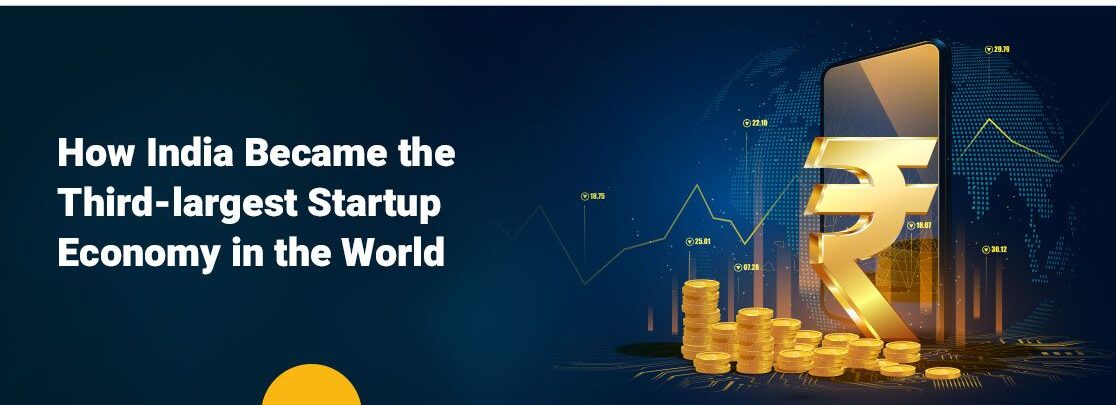From 452 startups in 2016 to 1,17,254 recognised startups in 2024, the Indian startup ecosystem has grown exponentially. These Indian startups offer solutions and services in 56 diverse sectors. This includes –
- Information Technology
- Finance
- Supply chain
- Life sciences and healthcare
- Education
- Agriculture
- Professional and commercial services
In the past decade, the innovation ecosystem has enabled startups to raise over USD 130 billion in investor funding.
India’s rise to the third-largest startup ecosystem in the world can be attributed to various factors. These factors include a digital infrastructure of 800 million plus Internet users (4), 5G, and extensive rural broadband connectivity.
The digital landscape also provides e-commerce and fintech platforms like Amazon, Nykaa, Razorpay, Paytm, and Dunzo, transforming its socioeconomic status. India’s tech-savvy population and affordable smartphones and data plans have further fuelled startup growth in the country.
Government Initiatives and Startup Ecosystem
The Government of India (GoI) has supported the startup ecosystem through various initiatives, schemes, and policies. The government’s flagship – The government launched the Startup India initiative on 16th January 2016 and comprises multiple action items that include –
- The funds of funds scheme (FFS)
- Regulatory reforms
- Incubation centres
- International market access
- The startup India online hub
- The Seed Fund Scheme and National Startup Awards (NSA).
The Government of India also eased several processes. Starting from registration of businesses to procurement of licences, labour and environment law self-certifications, and support for intellectual property protection.
The GoI has also been boosting the spirit of entrepreneurship and innovation among the youth through initiatives such as:
- India Digital India
- Skill India
- Stand-up India
- Make in India
- Mudra Yojana
This has led to establishing multiple business incubators, such as T-Hub, that support startups through all their stages.
Harnessing India’s Large Talent Pool
India has a demographic dividend. There’s an educated workforce with skills relevant to today’s technologically advanced and digital economy.
The 40,000 (5) colleges and universities offering engineering and information technology courses produce 1.5 million graduates annually. This is across disciplines of artificial intelligence (AI), machine learning (ML), data science, the Internet of Things (IoT), STEM, etc.
Out of these, more than 7.68 lakh skilled individuals are part of the Indian startup ecosystem. The students will be able to contribute 4-5 per cent to innovation and the GDP in India (6). How? India’s job creation growth rate will be 24 per cent annually between 2022 and 27.
What’s more? The youth are interested in technological innovation, research, and disruptive solutions, contributing to a gig economy. The gig economy will have 23.5 million freelancers and young contractual workers by 2030 (7), as per Niti Aayog.
The Growing Investor Attraction
In recent years, the Indian startup ecosystem has attracted increasing interest and investments from domestic and foreign sources. The startups have raised USD 13.2 billion in 2019 and USD 24 billion in 2022. The fundraising was done through a series of rounds and Initial Public Offerings.
Venture capitalists like Sequoia Capital, Tiger Global Management, Blume Ventures, Accel, and more have funded 108 unicorns. With a total valuation of USD 332.7 billion (9) startup investor platforms have enabled funding across sectors like –
- E-commerce
- Fintech
- Data management and analytics
- Supply chain & logistics
- Gaming
- Edtech
An Emerging Startup Ecosystem in Tier 2 and Tier 3 Cities
Fifty per cent of the total Indian startups are set up in tier 2 and tier 3 cities (10) to find solutions and grow in untapped local markets. Multiple factors have led to the emergence of a startup ecosystem, such as –
- Wide-ranging local problems
- Entrepreneurial talent
- Lowered business costs
- Improved infrastructure
- Rise in private consumption
These startups apply AI, ML, and data science technologies to create an innovation ecosystem. Some have been a driving force for socioeconomic development in these regions. Jaipur, Ahmedabad, Indore, and Surat showed economic growth of 40 per cent (11) and are slowly becoming business incubation hubs.
The Startup Incubator Revolution
The number of startup accelerators and business incubators has grown fifteen times in the last two decades. Rising to 326 incubators, they are spread strategically across the country, mainly in South India, like T-Hub in Hyderabad. Sixty per cent of business incubators are in the non-metro cities. Startup incubator programs are helping them secure investments, develop viable products, connect with industry leaders, and more!
The evolving culture of remote and hybrid working, tax incentives and exemptions, technological advancements, and the growing Indian economy. These factors have made India into a large business incubation hub offering startups to grow. This has resulted in India becoming the third-largest startup ecosystem in the world.







